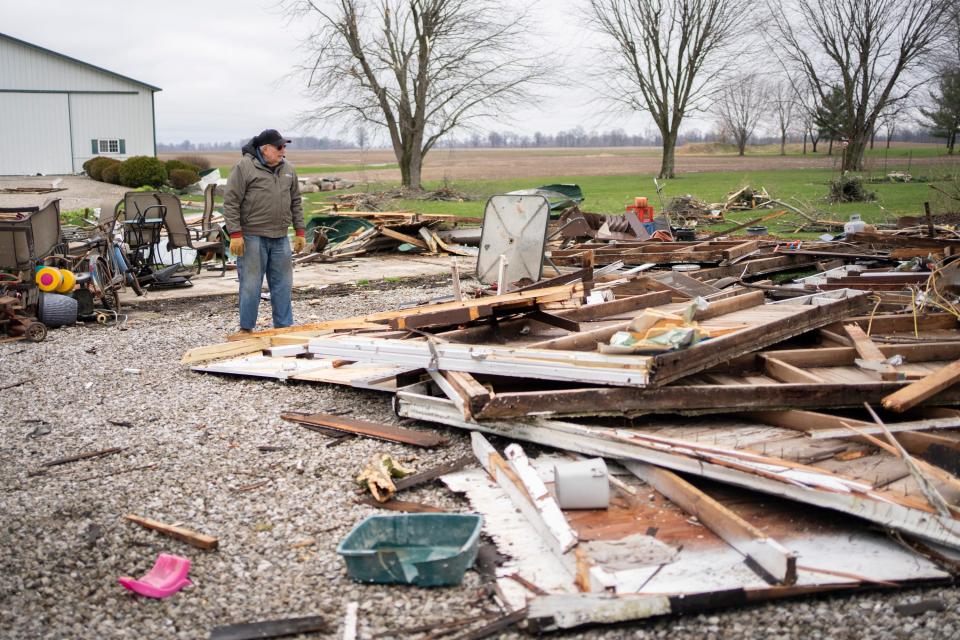Heavy storms raise Ohio insurance premiums, pricing some out of coverage

The storms that battered Ohio and the U.S. in the past few years, like the ones a week or so ago that killed three people and leveled a chunk of the Indian Lake region, are also taking a toll on the cost of insuring a home.
"Rates are going up across the country," said Mark Friedlander, director of corporate communications for the Insurance Information Institute, an industry group.
Rates climbed 10% to 12% last year in many parts of the country and are likely to go by a similar amount this year, he said.
In Ohio, where insurance tends to be more affordable than other parts of the country, rates for the top 10 homeowner insurers, climbed, on average, 3.8% in 2022, according to the most recent data from the Ohio Department of Insurance. That's the biggest increase since a 5% increase in 2018.
The last double digit increases in Ohio were in 2012-13.
The deadly storms were part of a larger storm system that left a trail of death, debris and destruction through Indiana, Ohio and parts of Kentucky. Early damage estimates say that the cost could hit hundreds of millions of dollars.
Those storms are building on what already was a costly 2023 when there were 28 separate billion-dollar weather and climate disasters, according to the National Oceanic and Atmospheric Administration. That beat the 2020 record when there were 22 billion-dollar weather disasters.
Claims were so high last year, that insurers paid out more than they took in from premiums, Friedlander said. Inflation also has been a major factor for insurers with the cost of construction materials and labor continuing to rise faster than the overall rate of inflation.
More homeowners going without coverage
With the cost of insuring a home on the rise, Friedlander said more homeowners are choosing to go without coverage.
Friedland said 12% of homeowners across the country no longer carry insurance on their property. That's more than double since before the pandemic.
"It's really frightening and a dangerous situation for the country," he said.
Communities that are well insured recover more quickly from storms like the one the struck Ohio last week, he said.
"Even with the best possible insurance, it's just so devastating to have your home destroyed by a tornado," he said.
Generally speaking, tornado and hail damage is covered under homeowners and renters insurance policies, and comprehensive auto coverage pays to repair or replace a covered vehicle damaged by hail or wind.
State Farm claims on the rise
Insurance claims from the storms that hit Indian Lake, Delaware County and elsewhere in Ohio are piling up just like the debris the tornadoes and hail left behind.
State Farm, Ohio's biggest home insurer with about a fifth of the state's market, already has received more than 1,000 home and auto claims from the storms, according to the insurer. Most of the damage is from wind and hail.
About 30,000 property and auto insurance storm claims had been filed across multiple states through yesterday, according to the insurer's group.
Columbus-based Nationwide declined to identify how many claims it has received so far.
"We have been reaching out to insurance agents and our members in affected areas with information on steps they can take to stay safe and file a claim if they need to," Nationwide said. "Our claims teams are poised and ready help our customers, and we have claims and catastrophe response team members who are already on the ground and being deployed to the heaviest impacted areas."
What homeowners should do
The first rule for homeowners dealing with damage is to be safe and never approach any downed power lines.
Nationwide recommends that once it's safe, take photos or video of the damage to your home, vehicle or property.
If possible, complete any temporary repairs to prevent further damage. But if needed, hire a professional. Save receipts and if you must dispose of property, take photos first.
If you need to file a claim, contact your agent or carrier as soon as possible.
If the home is uninhabitable, insurers can work to get the family settled someplace else quickly.
"Getting the impacted homeowners in a safe environment is paramount," Friedlander said.
Friedlander said insurers play a significant role in helping homeowners recover from a devastating storm, even writing checks on the spot to help policyholders cover basic living expenses.
"That's why insurance is so important," he said. "Property insurers act as a financial first responder."
Watch out for predatory contractors
Insurers warn homeowners to beware of predatory contractors that swoop in on neighborhoods after a storm.
"Insurers have preferred contractors that they've worked with and are licensed and registered by the state," Friedland said.
Nationwide, for example, will help customers find a contractor through its On Your Side Property Repair Network.
Prepare for hail season
The high winds, hail and tornadoes that struck Ohio last week may be a sign of things of come.
State Farm says April, May and June are the top three months for hail claims.
To help protect what's important, State Farm advises that cars should be put in the garage if possible to protect from flying debris. Items such as garbage cans, patio furniture, grills and other potentially wind-borne objects should be brought inside.
It's also a good time for homeowners to call their agent and conduct an annual review of their coverage to make sure they are adequately protected.
State Farm also says homeowners should update their home inventory and take photos or videos of everything in their home. Auto and home insurance policies, a home inventory and mortgage info should be kept in a safe location.
That can speed up the claims process and help with filing a claim.
mawilliams@dispatch.com
@BizMarkWilliams
This article originally appeared on The Columbus Dispatch: Powerful storms pushing up the cost of homeowner insurance
